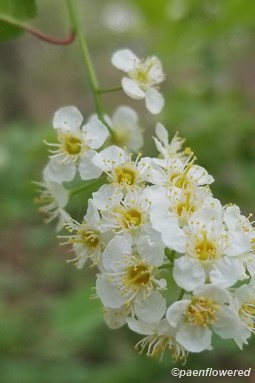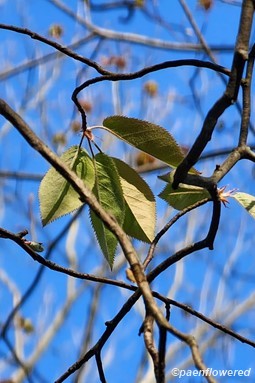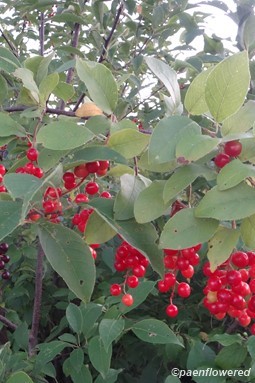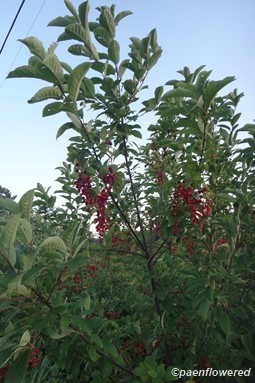Prunus virginiana
Easily adaptable and widely present shrub with clusters of white flowers in drooping racemes
Prunus virginiana chokecherry
A large, deciduous shrub or a small tree, often forming thickets. The flowers and leaves appear at about the same time in May. Flowers are borne on drooping racemes at the end of branches. Leaves are broad and oval-shaped, finely toothed. Petioles have a distinctive red color. Fruit color changes from green to red to dark purple.
Birds love the fruit and spread its seeds into various landscapes where chokecherry readily establishes.
Habitat & Range
Forest edges, fields, woodlands, rocky woods, border of swamps.
Present throughout the state.
| EMP: | FACU |
|---|---|
| NCNE: | FACU |
Phenology
Flowers April to early June. Flowers and leaves appear at the same time.
Fruits appear in August and last through September.
Characteristics
Flowers numerous, in nodding cylindrical racemes up to 4 inches long; five white round petals with an orange yellow center with a ring of yellow-tipped stamens with single central style; five sepals; pedicels are glabrous.
Leaves simple and alternate, ovate or obovate in shape and widest at or above the middle; upper surface is dark green and shiny, while lower surface of lighter green and usually smooth
Leaf margins finely serrated with sharp teeth
Petioles reddish in color, with glands at the apex
Fruit round, shiny drupe, turning from green to red to dark purple; 1/3 inch in diameter with a single hard seed. Sepals are not persistent and die off as the fruit develops
Bark not aromatic, brownish gray to gray, smooth but become rougher on older trunks
Height 10-25 feet
Identification Tips
Petioles are red in color.
White flowers are held in long, drooping racemes.
Similar Species
Prunus serotina (black cherry)
Black cherry does not have the same sharp teeth as chokecherry, only occasionally may have red petioles & has more narrow leaves than chokecherry.
Plant Codes
S-rank: S5 (Secure)
G-rank: G5 (Secure)







.jpg?v=638134808320000000)


Comments
Have you spotted this plant in your area? We'd love to hear about your experience! Share your comments or questions about the plant below. Comments are moderated before posting.